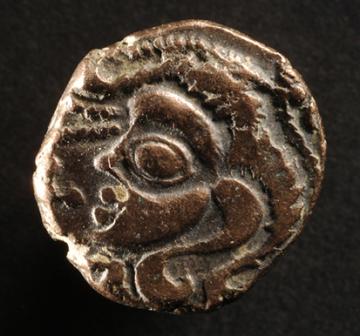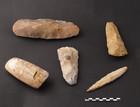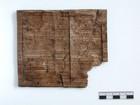You are here
News
- (-) Remove Discoveries filter Discoveries
A team from the Inrap recently excavated part of the cemetery of Gallo-Roman Evreux Mediolanum Aulercorum. One hundred and thirty four burials dated to the 3rd century AD were found between October 2006 and June 2007. In addition, the excavation has given archaeologists the opportunity to study a funerary practice previously unknown in Roman Gaul.
An Iron Age farm at Laniscat (Côtes-d'Armor) was recently discovered by a team from the INRAP. An exceptional Armorican Celtic coin hoard was also found. The excavation, preceding road building, was curated by the Regional Archaeology Service.
A team from the National Inrap is at present excavating the remains of a Neolithic village in the Vaures quarter of Bergerac. While the Bergerac region is well-known for high quality flints widely exploited during Prehistory, Neolithic dwellings in the area, on the contrary, are little known. The excavation is curated by the Regional Archaeology Service (DRAC Aquitaine).
An archaeological excavation was conducted Place de la Libération in Troyes, from 2004 to 2006 before the construction of an underground car park.The results of an interdisciplinary approach paint a picture of an emerging ancient city and the daily life of a newly Romanized urban population in the early years AD, particularly social status, dietary customs and state of health.
Numerous Neanderthal artifacts are currently being excavated by a team from the Inrap at Saint-Amand-les-Eaux (Nord). The excavation, taking place, in advance of the construction of a shopping centre, is curated by the Regional Archaeology Service, (DRAC Nord-Pas-de-Calais). An exceptionally well preserved human occupation around 50,000 years old has been found.
Mosaics have been found in the ancient residential quarter of Nimes by a team from the Inrap. The excavation precedes the construction of an underground car-park by the town of Nîmes and is curated by the Regional Archaeology Service.
Of the 300 excavations conducted yearly by Inrap, approximately 30% concern the Iron Age, a period which is currently the subject of intense research activity. While we cannot reduce the study of Celtic society to its elites, mortuary rites and aristocratic burials still offer the most spectacular discoveries. Inrap recently excavated several individuals buried with their ceremonial or combat chariots.
Africa is undergoing a massive campaign of spatial and infrastructural development, with rail and road networks, pipelines, forest and agricultural clearances, industrial areas and urban expansions.As they upturn the topsoil, these building works endanger numerous archaeological sites and remains which constitute together a vast and irreplaceable body of evidence for understanding Africa's history.









